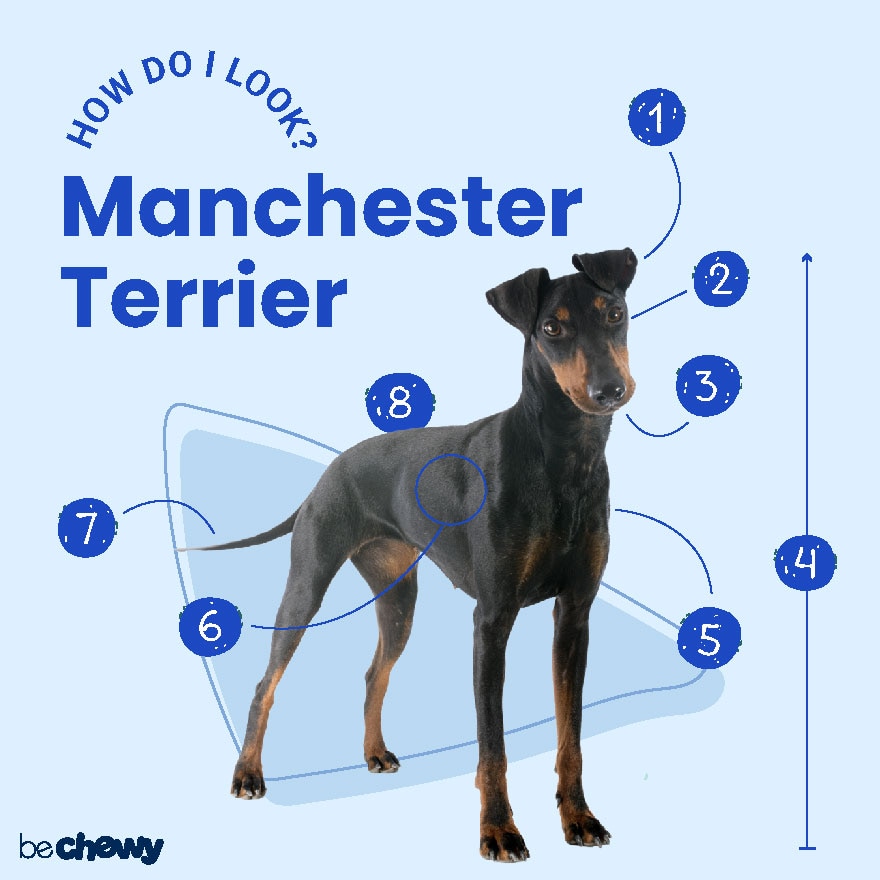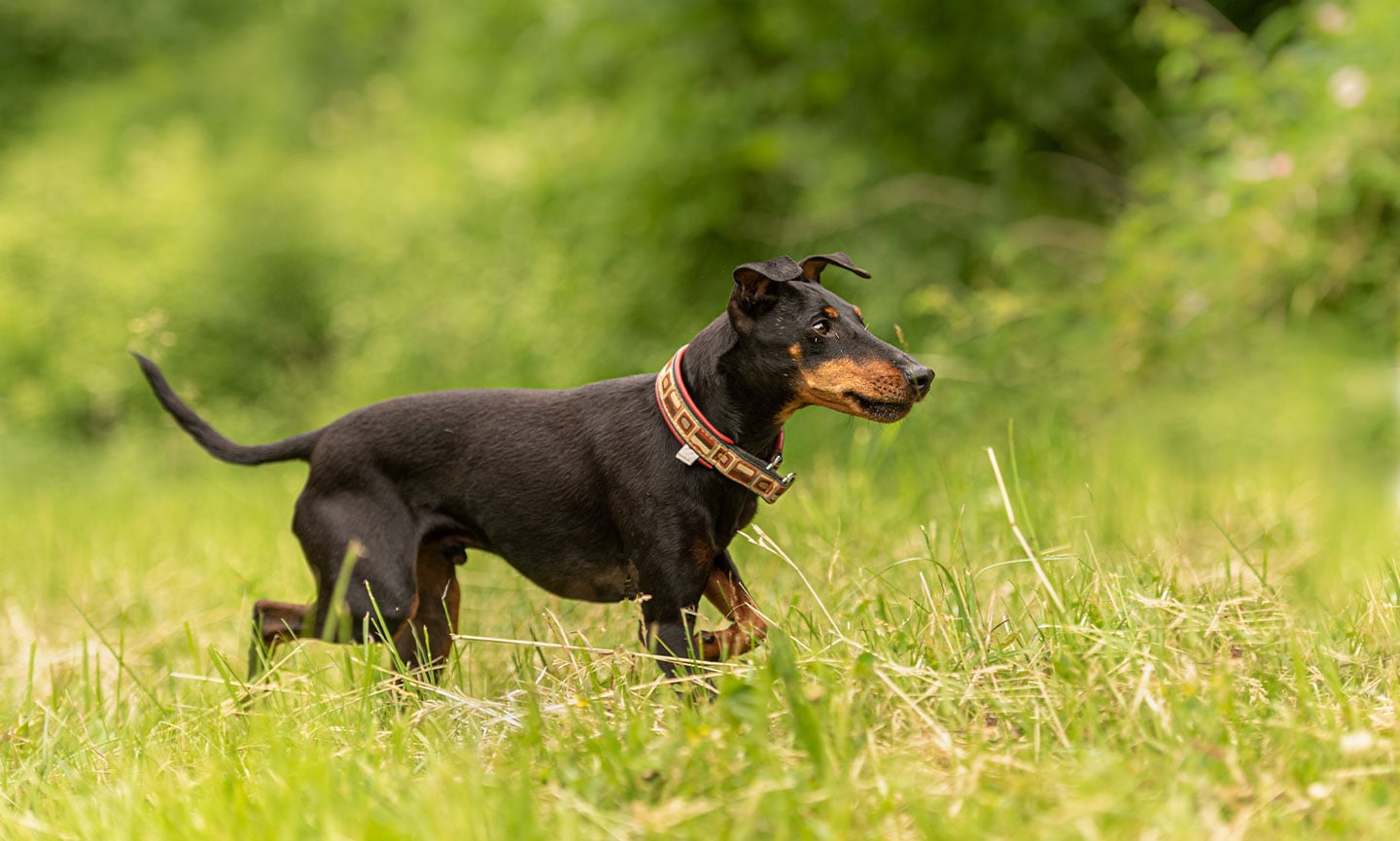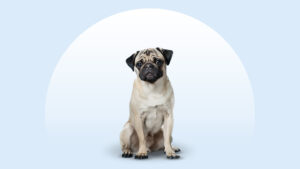Manchester Terrier
Updated May 5, 2025
Manchester Terrier
Updated May 5, 2025
Manchester Terriers are spirited, low-maintenance pups who need consistent exercise. They thrive in active homes with experienced pet parents who are ready to include them in all their activities (and don't mind the occasional zoomies).
Peppy, Playful, Alert
Male: Toy: 10-12 pounds
Standard: 12-22 pounds
Toy: 10-12 inches
Standard: 15-16 inches
15 to 17 years
Black and Tan
The Manchester Terrier is an energetic, bright, athletic and playful pup. They’re curious about all the things, but mostly, they want to know what you’re doing. Their sleek, athletic bodies are full of energy, and they will make you laugh with all their antics—they love clowning around and entertaining you with their zoomies! Manchesters are ready to join you on all your activities and will happily snuggle up with you for movie night.
Manchester Terrier Characteristics
Manchester Terrier Appearance
The Manchester Terrier dog comes in two types, standard and toy, and the only difference between the two are their size and their ears. Both varieties have shiny, black and tan short coats with tan markings that highlight their chest and legs. They stand at attention with their back legs tilted forward, and their back and neck slightly arched, ready to pounce. Sleek and muscular, they look like the high-performance dogs they are.

- Ears
The AKC breed standard for the standard Manchester Terrier allows for the ears to be cropped or natural. For toy Manchester Terriers, the ears must be natural. Cropping involves surgically cutting away part of a dog’s ears. Veterinary groups along with many U.S. states and countries have banned this procedure due to medical and behavioral reasons. If you are interested in this procedure, schedule a consultation with your veterinarian.
- Eyes
Their almond-shaped eyes are nearly black in color and are small, bright and sparkling.
- Nose
Manchester Terriers have black noses.
- Coat Length
Their coats are short, dense and smooth but not soft.
- Coat Color
Their coats are jet black with mahogany tan markings over the eyes, on the checks and throat, inside the ears and spots on each side of the chest above the front legs (called rosettes).
- Tail
Their tail is medium length, tapers to a point and curves slightly upward.
Manchester Terrier Temperament
Manchester Terriers are high-energy dogs who are constantly checking out their surroundings. Naturally curious by nature, these pups are known for their devotion and ability to entertain their families—they love chasing toys and zooming around when they have an audience.
Manchester Terriers are not generally aggressive (unless you’re a rodent), and the pups aren’t known to be biters. However, these highly intelligent and observant watchdogs are known to be barkers, so you’ll always know what’s coming down your street.
Manchesters do fine with kids as long as they’re properly socialized, but they may need considerable training to live with with other dogs or cats unless they’ve been raised with them since they were puppies. And you can forget about “pocket” pets like gerbils or rabbits. These pups were born for hunting rats, and they are likely to chase these types of pets.
They can be wary around strangers, but with socialization from puppyhood, they can learn to be OK when new people come around. But they will always let you know when someone’s at your door!
This playful pup enjoys games and will attack squeaky toys and chase balls with abandon. But Manchesters also enjoy physical closeness and companionship, so they’re always ready for snuggles. Therefore, they may not like being left alone all day. If you’re not able to be with them for most of the day, check them into doggie daycare or arrange for a pet sitter or neighbor to come by for a play date.
How to Care for a Manchester Terrier
Manchester Terriers need a moderate amount of care. Thankfully, their smooth, glossy coats are a snap to maintain. This leaves you with plenty of time to bond with your pup over the many training sessions, playtimes and outings you’ll be taking to manage their intelligence and their energy levels.
Grooming
Training
Diet
Exercise
Environment
Manchester Terrier Health
The Manchester Terrier has a lifespan of 15 to 17 years and has a moderate amount of health issues. It’s important to be aware of these health problems so you can help your pup live the longest life possible.
- Patellar Luxation: This often-hereditary skeletal condition occurs when the kneecap slips out of place. Treatment options include weight management, limited exercise, pain or anti-inflammatory medication and surgery, depending on the severity.
- Juvenile Cardiomyopathy: This condition affects the heart muscle’s ability to contract normally. Signs are often first noticed at 6-8 weeks of age and include trouble breathing and fainting. There is no cure or treatment, and sudden death can occur. Genetic screening testing is now available so be sure to ask your breeder.
- Von Willebrand’s Disease: This is an inherited blood clotting disorder that can lead to excessive bleeding from injuries or surgery; however, day to day an affected dog is typically asymptomatic. Blood transfusions may be needed if the pup experiences a trauma or needs to have surgery.
- Progressive Retinal Atrophy (PRA): PRA is a degenerative disease that can cause a dog to go blind. There is no treatment for it, but a dog with vision loss can still live a happy life. Genetic screening testing is available so be sure to ask your breeder.
- Hypothyroidism: Hypothyroidism is a condition in which the dog’s thyroid doesn’t produce enough thyroid hormone. Diagnosis is typically with a blood test and treatment is most commonly a daily oral medication.
Manchester Terrier History
The Manchester Terrier breed origins can be traced back to the late 1570s and their ancestors, the Black and Tan Terrier. In the early 1800s, a breeder named John Hulme from Manchester, England, crossed the Black and Tan Terrier with the Whippet to get the sleek Manchester Terrier, who were proficient rodent killers, vermin hunters and course-game dogs (dogs who chased lures around a track).
The breed’s popularity soared in the Victorian era. Men in Victorian England prized this breed as a gentleman’s dog for their sleek looks and ratting prowess. (Rats were a big problem at the time, so naturally, a dog who excelled at rat killing was prized.) However, Victorian women preferred a smaller dog, so the toy version of the pup was developed. The only difference between the two types (standard and toy) are their size and their ears: the standard can have naturally erect, folded or cropped ears, and the toy only has naturally erect ears.
The American Kennel Club first recognized the Toy Manchester Terrier in 1886 and the Standard Manchester Terrier in 1887. But in 1959, the two types were put together in one breed, the Manchester Terrier. (Naturally, the standard is in the Terrier group and the the toy is in the Toy group.)
So, where’s the best place to find a Manchester Terrier puppy today? Find a list of reputable breeders on the American Kennel Club’s website. In terms of cost, expect to spend about $600 to $1,000 for a Manchester Terrier puppy, depending on the breeder. But for that price, the pups are typically screened for health and temperament issues and may come with pedigree papers. Contact Manchester Terrier breed rescue organizations for adoption or check your local animal shelter to adopt a pup. Search Chewy’s database of adoptable dogs in your area.
FAQs
Do Manchester Terriers shed?
Are Manchester Terrier good family dogs?
How big do Manchester Terriers get?
Do Manchester Terriers bark a lot?
What are the most common Manchester Terrier mixes?
Expert input provided by Kathy Nissan, Secretary for the American Manchester Terrier Club (AMTC) and owner of WhirlWynd Manchesters, and Krissia Chanto, vet tech and co-owner of Rock Paw Pet Care.
Breed characteristic ratings provided by veterinarian Dr. Sarah J. Wooten, DVM, CVJ, a veterinarian at Sheep Draw Veterinary Hospital in Greeley, Colorado; dog trainer and behavior consultant Irith Bloom, CPDT-KSA, CBCC-KA, CDBC, owner of The Sophisticated Dog, LLC, in Los Angeles; and certified animal behavior consultant Amy Shojai, CABC, in Sherman, Texas.
The health content was medically reviewed by Chewy vets.








